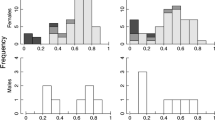Summary
The influence of resident females on the settling patterns of subsequent females was examined for marsh wrens (Cistothorus palustris). Proportionally more females responded to a playback of a female intruder during the pre-laying stage than during the laying and incubation stages. The strength of the response was also greatest during pre-laying and laying stages (Table 1). Female wrens did not settle randomly with respect to the presence of other females, but rather settled with bachelor males more often than predicted by chance (Table 3). Female settlement within territories was more asynchronous than settlement between territories. An attempt to fit these data to two models of female settlement suggested that prospecting females were not displaced by residents, but rather avoided settling with mated males (Table 3). Females within territories were also more dispersed than predicted by chance, a pattern that may be enforced through aggression on the part of the resident female. Staggered settlement reduces the overlap in nestling stages of harem mates and so may be a strategy to reduce competition for resources at this critical stage.
Similar content being viewed by others
References
Alatalo R, Lundberg A, Glynn C (1986) Female pied flycatchers choose territory quality not male characteristics. Nature 323:152–153
Altmann SA, Wagner SS, Lenington S (1977) On the evolution of polygyny. Behav Ecol Sociobiol 2:397–410
Carey M, Nolan V Jr (1979) Population dynamics of indigo buntings and the evolution of avian polygyny. Evolution 33:1180–1192
Catchpole C, Leisler B, Winkler H (1985) Polygyny in the great reed warbler,Acrocephalus arundinaceus: a possible case of deception. Behav Ecol Sociobiol 17:1–7
Clark PJ, Evans FC (1954) Distance to nearest neighbor as a measure of spatial relationships in populations. Ecology 35:445–454
Garson PJ (1980) Male behaviour and female choice: mate selection in the wren? Anim Behav 28:491–502
Garson PJ, Pleszczynska WK, Holm CH (1981) The polygyny threshold model: a reassessment. Can J Zool 59:902–910
Hannon SJ (1984) Factors limiting polygyny in the willow ptarmigan. Anim Behav 32:153–161
Holm CH (1973) Breeding sex ratios, territoriality, and reproductive success in the red-winged blackbird (Agelaius phoeniceus). Ecology 54:356–365
Hurly TA, Robertson RJ (1985) Do female red-winged black-birds limit harem size? a removal experiment. Auk 102:205–209
LaPrade HR, Graves HB (1982) Polygyny and female-female aggression in red-winged blackbirds (Agelaius phoeniceus). Am Nat 120:135–138
Lenington S (1980) Female choice and polygyny in red-winged blackbirds. Anim Behav 26:347–361
Leonard ML (1986) Female choice and the evolution of polygyny in the marsh wren (Cistothorus palustris). Unpubl PhD thesis, University of Ottawa, Ottawa
Leonard ML, Picman J (1987a) Mate choice by marsh wrens: the influence of male and territory quality. Anim Behav (in press)
Leonard ML, Picman J (1987b) Nesting mortality and habitat selection by marsh wrens. Auk (in press)
Nero RW (1956) A behavior study of the red-winged blackbird. I. Mating and nesting activities. Wilson Bull 68:5–37
Orians GH (1969) On the evolution of mating systems in birds and mammals. Am Nat 103:589–603
Picman J (1977) Intraspecific nest destruction in the long-billed marsh wren,Telmatodytes palustris palustris. Can J Zool 55:1997–2003
Picman J (1980) The impact of marsh wrens on reproductive success of red-winged blackbirds. Can J Zool 58:337–350
Picman J, Belles-Isles J-C (1987) Intraspecific egg destruction in marsh wrens; a study of mechanisms preventing filial ovicide. Anim Behav 35:236–246
Pleszczynska WK (1978) Microgeographic prediction of polygyny in the lark bunting. Science 201:935–937
Searcy WA (1979) Female choice of mates: a general model for birds and its application to red-winged blackbrids (Agelaius phoeniceus). Am Nat 114:77–100
Stutchbury BJ, Robertson RJ (1987) Do nest building and first egg dates reflect settlement patterns of females? Condor (in press)
Verner J (1964) Evolution of polygamy in the long-billed marsh wren. Evolution 18:252–261
Verner J (1965) Breeding biology of the long-billed marsh wren. Condor 67:6–30
Verner J, Willson MF (1966) The influence of habitat on mating systems of North American passerine birds. Ecology 47:143–147
Verner J, Engelsen GH (1970) Territories, multiple nest building and polygyny in the long-billed marsh wren. Auk 87:557–567
von Haartman L (1969) Nest-site and evolution of polygamy in European passerine birds. Ornis Fenn 46:1–12
Weatherhead PJ, Robertson RJ (1979) Offspring quality and the polygyny threshold: “The sexy son hypothesis.” Am Nat 113:201–208
Welter WA (1935) The natural history of the long-billed marsh wren. Wilson Bull 47:3–34
Wittenberger JF, Tilson RL (1980) The evolution of monogamy: Hypotheses and evidence. Ann Rev Syst 11:197–232
Yasukawa K (1981) Male quality and female choice of mate in the red-winged blackbird (Agelaius phoeniceus). Ecology 62:922–929
Yasukawa K, Searcy WA (1981) Nesting synchrony and dispersion in red-winged blackbirds: is the harem competitive or cooperative? Auk 98:659–668
Yasukawa K, Searcy WA (1982) Aggression in female redwinged blackbirds: a strategy to ensure male parental investment. Behav Ecol Sociobiol 11:13–17
Author information
Authors and Affiliations
Rights and permissions
About this article
Cite this article
Leonard, M.L., Picman, J. Female settlement in marsh wrens: is it affected by other females?. Behav Ecol Sociobiol 21, 135–140 (1987). https://doi.org/10.1007/BF02395442
Received:
Accepted:
Issue Date:
DOI: https://doi.org/10.1007/BF02395442




